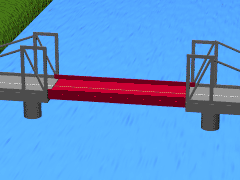 An animation showing how a vertical-lift bridge operates with vehicular and shipping traffic | |
| Ancestor | Truss bridge |
|---|---|
| Related | Bascule bridge, swing bridge, folding bridge, retractable bridge |
| Descendant | Submersible bridge, table bridge |
| Carries | Automobile, pedestrians, truck, light rail, heavy rail |
| Span range | Short |
| Material | Steel |
| Movable | Yes |
| Design effort | medium |
| Falsework required | Depends upon degree of prefabrication |
A vertical-lift bridge or just lift bridge is a type of movable bridge in which a span rises vertically while remaining parallel with the deck.
Contents
The vertical lift offers several benefits over other movable bridges such as the bascule and swing-span bridges. Generally speaking, they cost less to build for longer moveable spans. [1] The counterweights in a vertical lift are only required to be equal to the weight of the deck, whereas bascule bridge counterweights must weigh several times as much as the span being lifted. As a result, heavier materials can be used in the deck, and so this type of bridge is especially suited for heavy railroad use. The biggest disadvantage to the vertical-lift bridge (in comparison with many other designs) is the height restriction for vessels passing under it, due to the deck remaining suspended above the passageway.
Vertical-lift bridges gained popularity in the late 19th century as steam-powered vessels began to replace the tall ships that necessitated the height clearances afforded by bascule or swing-span bridges. They were especially popular in the Great Lakes region, where the frequency of both rail and maritime traffic made them a cost-effective choice. [2]
Most vertical-lift bridges use towers, each equipped with counterweights. The oldest operating example is the Hawthorne Bridge over the Willamette River in Portland, Oregon, built in 1910.
Another design uses balance beams to lift the deck, with pivoting bascules located on the top of the lift towers. [3]













